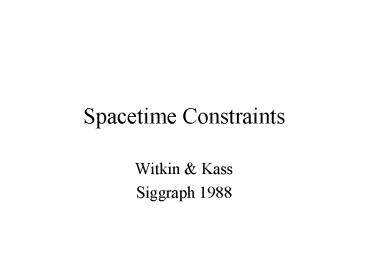Spacetime Constraints - PowerPoint PPT Presentation
1 / 13
Title:
Spacetime Constraints
Description:
Spacetime Constraints. Witkin & Kass. Siggraph 1988. Overview. Unlike common ... Specify the high-level spacetime constraint and let the optimization solve for ... – PowerPoint PPT presentation
Number of Views:29
Avg rating:3.0/5.0
Title: Spacetime Constraints
1
Spacetime Constraints
- Witkin Kass
- Siggraph 1988
2
Overview
- Unlike common Newtonian dynamic simulation, the
due driving force is unknown - Specify the high-level spacetime constraint and
let the optimization solve for the position and
force unknowns by minimizing the energy
consumption
3
(No Transcript)
4
Lamp on floor
5
Problem Statement (single particle)
Governing Equation (Motion Equation)
Boundary Conditions
f(t)
g
Object Function (Energy Consumption)
6
Discretize continuous function
Discretize unknown function x(t) and f(t)
as x1, x2, xi, xn-1, xn f1, f2, fi,
fn-1, fn Our goal is to solve these
discretized 2n values x1?xn satisfies goals
while optimizing f1?fn Next step is to discretize
our motion equation and object equation.
i
1
n
7
Difference Formula
h
h
xi - 0.5
xi 0.5
xi - 1
xi
xi 1
Backward
Forward
Central
Central
8
Discretized Function
Motion equation
x
x4, f4
x3, f3
x2, f2
Boundary Conditions
x1, f1
t
Object Function
When does R have minimum value?
9
Generalize Our Notation
Unknown vector S (S1, S2, Sn)
x
x4, f4
Constraint Functions Ci(S) 0
x3, f3
x2, f2
x1, f1
Minimize Object Function R(S)
t
S (x1, x2, x3, x4, f1, f2, f3, f4)
10
Sequential Quadratic Programming (SQP) Step One
Pick a guess S0, evaluate
Most likely
Taylor series expansion of function f(x) at point
a is
Similarly, we have
Set equal to 0
Omit
Sa is the change to S0 that makes derivative
equal to 0
11
SQP Step Two
Now we got S1, evaluate our constraints Ci(S1),
if equal to 0, we are done but most likely it
will not evaluate to 0 in the first several steps.
So, lets say Ci(S1) ? 0, lets apply Taylor
series expansion on the constraint function Ci(S)
at point S1
Omit
Set equal to 0
Sb is the change to S0 that makes derivative
equal to 0
Then we will continue with step one and step two
until we got a solution Sn which minimizes our
object function and also satisfies our
constraints.
S0 ? S1 ? S1 ? S2 ? S2 ? ? Sn
12
Graphical Explanation of SQP
C(S)
S1
S2
S2
S
S0
S1
13
(No Transcript)































